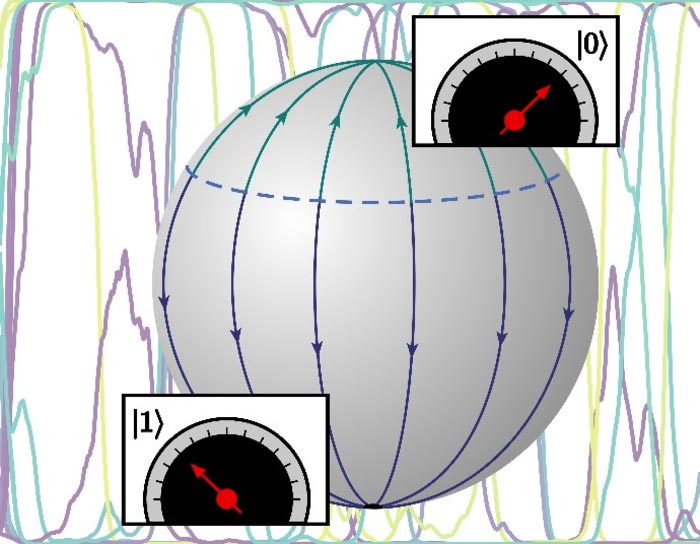Constraining quantum measurement

Despite the fuzziness of the quantum world, measurements of quantum particles yield precise outcomes in our everyday world. How does the act of measuring achieve this transformation?
Image by Jasper van Wezel
The quantum world and our everyday world are very different places. In a publication that appeared as the “Editor’s Suggestion” in Physical Review A this week, UvA physicists Jasper van Wezel and Lotte Mertens and their colleagues investigate how the act of measuring a quantum particle transforms it into an everyday object.
Quantum mechanics is the theory that describes the tiniest objects in the world around us, ranging from the constituents of single atoms to small dust particles. This microscopic realm behaves remarkably differently from our everyday experience – despite the fact that all objects in our human-scale world are made of quantum particles themselves. This leads to intriguing physical questions: why are the quantum world and the macroscopic world so different, where is the dividing line between them, and what exactly happens there?
Measurement problem
One particular area where the distinction between quantum and classical becomes essential is when we use an everyday object to measure a quantum system. The division between the quantum and everyday worlds then amounts to asking how ‘big’ the measurement device should be to be able to show quantum properties using a display in our everyday world. Finding out the details of measurement, such as how many quantum particles it takes to create a measurement device, is called the quantum measurement problem.
As experiments probing the world of quantum mechanics become ever more advanced and involve ever larger quantum objects, the invisible line where pure quantum behaviour crosses over into classical measurement outcomes is rapidly being approached. In an article that was highlighted as “Editor’s Suggestion” in Physical Review A this week, UvA physicists Jasper van Wezel and Lotte Mertens and their colleagues take stock of current models that attempt to solve the measurement problem, and particularly those that do so by proposing slight modifications to the one equation that rules all quantum behaviour: Schrödinger’s equation.
Born’s rule
The researchers show that such amendments can in principle lead to consistent proposals for solving the measurement problem. However, it turns out to be difficult to create models that satisfy Born’s rule, which tells us how to use Schrödinger’s equation for predicting measurement outcomes. The researchers show that only models with sufficient mathematical complexity (in technical terms: models that are non-linear and non-unitary) can give rise to Born’s rule and therefore have a chance of solving the measurement problem and teaching us about the elusive crossover between quantum physics and the everyday world.
Journal: Physical Review A
DOI: https://doi.org/10.1103/PhysRevA.104.052224
Method of Research: Experimental study
Article Title: Inconsistency of linear dynamics and Born’s rule
Article Publication Date: 29-Nov-2021
Media Contact
Laura Erdtsieck
Universiteit van Amsterdam
persvoorlichting@uva.nl
Office: 0031-205-252-695
All latest news from the category: Physics and Astronomy
This area deals with the fundamental laws and building blocks of nature and how they interact, the properties and the behavior of matter, and research into space and time and their structures.
innovations-report provides in-depth reports and articles on subjects such as astrophysics, laser technologies, nuclear, quantum, particle and solid-state physics, nanotechnologies, planetary research and findings (Mars, Venus) and developments related to the Hubble Telescope.
Newest articles

Innovative 3D printed scaffolds offer new hope for bone healing
Researchers at the Institute for Bioengineering of Catalonia have developed novel 3D printed PLA-CaP scaffolds that promote blood vessel formation, ensuring better healing and regeneration of bone tissue. Bone is…

The surprising role of gut infection in Alzheimer’s disease
ASU- and Banner Alzheimer’s Institute-led study implicates link between a common virus and the disease, which travels from the gut to the brain and may be a target for antiviral…

Molecular gardening: New enzymes discovered for protein modification pruning
How deubiquitinases USP53 and USP54 cleave long polyubiquitin chains and how the former is linked to liver disease in children. Deubiquitinases (DUBs) are enzymes used by cells to trim protein…


